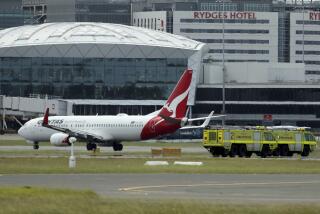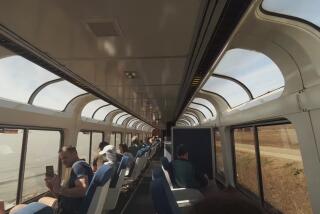How many meals were served on that 19-hour flight? Fewer than you’d think
- Share via
Aside from International Space Station astronauts, most us would find 19 hours and 16 minutes an excruciatingly long time to spend in the air. Forty-nine passengers and crew members endured that record-setting flight time aboard a 787 Dreamliner nicknamed Kookaburra.
It took off from New York City and didn’t stop until Sunday when it landed in Sydney, Australia. The flight was part of a series of test flights for the Australia-based Qantas Airways, which hopes to have direct long-haul flights up and running as soon as 2022.
All that time in the air must mean lots of food service, right? Not so.
“To keep the weight down, there’s no cargo, and food and drink are limited,” writes Bloomberg’s Angus Whitley, who was on the flight. Indeed, half the aircraft weight was the plane, people and bags; the other half was fuel, 101 tons of it.
Just three meals were served: dinner after takeoff, lunch six hours later, and breakfast before landing. No snacks were served, but passengers could request something if they were hungry, according to Qantas.
Even with those limitations, the menu proved to be inspired. Dinner started with spicy tomato and saffron soup, and green papaya salad with poached prawns. Pasta with tomato and eggplant sauce, Chinese braised beef short ribs with bok choy, chicken breast with Mexican rice, and Jiangxi-style white fish with jasmine rice were among the entrée offerings. A lemon curd tartlet and coffee rounded out the meal.
Passengers were encouraged to stay awake for the next six hours and then were served lunch: roast sweet potato soup, a chicken and Swiss cheese toasted sandwich, and a dessert of panna cotta trifle with raspberries and toasted almonds.
Breakfast came before the plane landed in Sydney. Choices included wild berry granola, Bircher muesli, fruit salad and an apple Danish, as well as egg with smoky bacon, poached eggs and ancient grains, or an egg white omelet with balsamic herb tomatoes, kale and portobello mushrooms.
Beverages on board included water, sparkling mineral water, coconut water, kombucha, tea, coffee, Champagne and wine.
Qantas planned studies of the pilots (monitoring their “brain waves, melatonin levels, and alertness”) to study the effects of fatigue and jet lag, part of what it calls Project Sunrise. Adjusting cabin lighting and meal service times also were considered because they may play a role in reducing jet lag, according to the airline.
Here are some other facts about the flight:
It was flown by four pilots on a rotating schedule, with two more pilots in the cabin.
It’s more than 10,000 miles between New York City and Sydney, a flight that usually takes 22 hours and 20 minutes, with a stop in Los Angeles.
The flight started at a cruising altitude of 36,000 feet and, as fuel burned and weight lightened, climbed to 40,000 feet.
Two more research flights are planned, the airline said in a news release: London to Sydney in November, and another New York to Sydney in December.
More to Read
Sign up for The Wild
We’ll help you find the best places to hike, bike and run, as well as the perfect silent spots for meditation and yoga.
You may occasionally receive promotional content from the Los Angeles Times.







